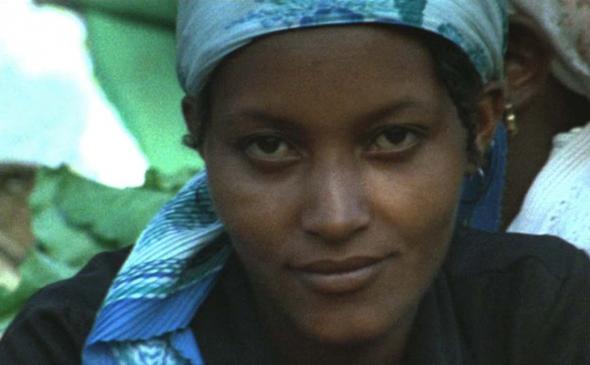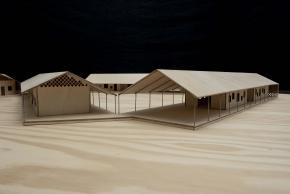Sunless - Return to Guinea-Bissau
In “Sunless” a man talks about his travels and the things he’s seen. This 1982 film is like a long letter – sent by the director, Chris Marker. Sunless is the poste restante of images and memories from around the world. The man and his camera were in many places: Iceland, Japan, America, Portugal, Cape Verde and Guinea-Bissau. The man returns to this African land and its islands to ask a question: “Why should so small a country, and one so poor, interest the world? They did what they could. They freed themselves.” He found the answer in the markets of Bissau, when the women treated him as an equal: “But the problems started and went on, and are still going. Rather unexciting problems for the revolutionary romanticism: to work, to produce, to distribute, to overcome postwar exhaustion, temptations of power and privilege.” In the comfort of his world, Marker knew it wouldn’t be possible to understand hunger and thirst. Even so, one had to “stare back”1. Return to one’s memories to build other new ones.
 Chris Marker, Sans Soleil, 1983
Chris Marker, Sans Soleil, 1983
Today, returning to that place, the problem remains the same. The Portuguese presentation at the 2009 São Paulo Architecture Biennial, “Five Africas/Five Schools”, reflects the different realities of the African countries whose official language is our own: for each of them a school prototype developed by a like number of architecture teams. For Guinea-Bissau, Pedro Maurício Borges has designed a Basic School in the city of Cacheu. In a context of extreme poverty2, the possibility of building a school should suffice to suspend any other kind of critical judgment. Nevertheless, beyond the initiative’s eventual humanitarian value, there is still architecture. In a place where like everything else it is limited by what exists, one has to make do with very little. But with many other things as well: with memories of a country that interested the world.
On 26 July 2009 Pedro Maurício Borges travelled to Guinea-Bissau accompanied by his colleagues Filipe Ferreira and Paulo Vaz. During their five-day stay they visited the project site, contacted the main intermediaries and worked out the school’s programme. This was much facilitated by the intervention of Portuguese Ambassador António Ricoca Freire and Cacheu Region Governor Col. Pedro Pereira Barreto. On 29 July 2009 results were announced of the country’s second round of presidential elections, which had taken place three days beforehand. With the recent inauguration of the winner, Malam Bacai Sanhá3, one can only hope for the urgent pacification of Guinea-Bissau. Perhaps a new Basic School for its children can be a small sign of this.
The city of Cacheu has less than 10,000 inhabitants and lies in the northwest, on the river of the same name. On the other shore, beyond São Domingos, is Senegal. It was in Cacheu that the Portuguese established their first trading post in the territory, in 1588. For a century it served as an entrepôt for merchandise and slaves exported to the home country, elsewhere overseas and the Americas. A small fort from those times is still standing, a military structure by the river’s mouth. Like in a Joseph Conrad novel, the estuary and tarrafe4 trees also recall those arrivals and departures. As in other small cities (Bolama, Bissorã or Cachungo), Cacheu’s urban centre is very small and dispersed. As a general rule, the houses and buildings are randomly arranged between areas of forest and bush.
The Basic School will be located in the Campo district, south along the coast, where the June 25th School (abandoned), Bartolomeu Simões Pereira School and Chinese School are also situated. The latter, built entirely without materials or manpower from Guinea-Bissau, was offered by the government of the People’s Republic of China – yet another example of its ‘advanced capitalism’. The new school is to be located after this group, next to three pavilions arranged in a U which the local community built (one of them in ruins) and a cashew grove. It is bordered by two paths that meet, one crossing the grove in an east-west direction and the other passing by a football field (to reposition) in a north-south direction. The programme includes six classrooms, one room for Portuguese language (under the PASEG5), a covered recreation area, dining hall with kitchen, bathrooms and water tank. It also includes a two-bedroom house for the director. With this home, a resident teacher can ensure building upkeep and security.6
A survey of available resources was conducted, given that the Basic School should be built only using Guinea-Bissauan raw materials and manpower. The contingencies determined a generic configuration noted in many other constructions in the country. A packed earth platform is contained by concrete blocks and levelled with a screed. Construction of the walls also begins with concrete blocks, which are overlaid with adobe (or taipa7) blocks. Platforms and walls are of a reddish earth colour. The roof structure comprises tubular iron (or cibe8) rafters covered by corrugated zinc sheets. It projects beyond the walls and covers the entire platform, where vertical iron tubes support the eaves. Doors and gates close the bays. Frames are non-existent on the market and their use is not advised, due to risk of theft or damage.
The Cacheu Basic School by Pedro Maurício Borges has a triangular plan; the construction of each side is identical to the above description. One faces north, while the other two converge on the south-facing entrance. Next to it stands the director’s house. The property is separated from the exterior by an oval barrier hedge in which the school triangle is inserted. The classrooms are arranged separate from each other on either side of the entrance. On the other side is the Portuguese language room, the dining hall and covered recreation area. These pavilions are delimited by brick grills, except for the covered recreation area. Here and around the rooms, below the metal roof, children can play. Out of the sun – sunless.
The very hot and humid climate explains the construction and plan. The roof eaves and concrete blocks in the platforms and walls protect the rooms during the rainy season. Its dominant south and southwest winds, along with those from the north and northeast during the dry season, determine the pavilions’ orientation. The space between rooms, doorways, windows and brick grills lets the air pass through.
But this architecture can also be accomplished with many other things. With the memories of its designer, Pedro Maurício Borges, who returned to the Guinea-Bissau of his childhood, during his father’s military service; certainly with the memories of another island chain, the Azores, where he has lived and still works. Like in a Joseph Conrad novel, there he found a landscape which charts the life of its men, where departures and arrivals made a new world9. Maurício Borges is evidently fascinated by these discoveries: the possibility that architecture can be the pretext for an expedition to terra incognita.
With their ‘plain’ appearance, the buildings he has designed and built use observation as a scientific though also playful act. More than a language, the results of this process aspire to be things amongst other things set down in the architect’s log book.
The Cacheu Basic School is therefore not just the result of climate-related and logistical conditions. Despite them, a school should always make room for invention. Here the pavilions arranged in a triangle around a court invent a small hamlet. As in any cluster, it lives according to its rules and exceptions. The director’s house is one, almost in ‘jest’.
It is placed next the entrance (so the community can care for the resident who must in turn care for the children) with the roof pitch diagonal to its square plan. These exceptions occur where the sides meet, in the way the roofs and platforms touch each other. Or then in the hedge’s oval loop, which is a pure design decision.
“Five Africas/Five Schools” aims to be an action, more than just a simple exhibition of designs. But only these can contain all the memories called forth by the process and build other new ones, by means of the schools. Their reality depends on a ‘sustainable’ awareness of things, as opposed to a sort of ‘narcissism’. This stance is not contested, though it is worth recalling that not only forms suffer from ‘misfortunes of virtue’, but words as well. In the comfort of our world, what’s supposedly sustainable has produced an industry of contents in open expansion. That’s how (and also with words) a ‘late capitalism’ absorbs its potential conflicts. Forty years ago Manfredo Tafuri summed up this problem: “the higher the sublimation of conflicts on the level of form, the more hidden the structures which that sublimation legitimates and confirms.”10 The ideology of an action is therefore a problem of form and its terms.
Portuguese architecture was once ‘architecture of resistance’. If anything remains of that resistance perhaps it is the ability to record its past. The rest, such as invoking scarcity, is just romanticism. In Guinea-Bissau, where there’s a lack of nearly everything, to build a new memory such as the Cacheu Basic School may well be an action against oblivion. “History throws its empty bottles out the window,” can be heard in Sunless.
In a recent statement Álvaro Siza maintained that his profession’s merit was that of cultural resistance. With this in mind, it is worth concluding with the universal meaning found in the words of Amílcar Cabral (1924-1973):
“Our viewpoint is therefore that in our culture we should resist in order to preserve what is in fact useful and constructive, but with the certainty that as we progress our clothing, our way of eating, our way of dancing and singing, everything, will have to change bit by bit, and more so our mindset, our sense of relations with nature and even our relations with others.”11
 Pedro Maurício Borges. Basic School, Cacheu, Guinea-Bissau.
Pedro Maurício Borges. Basic School, Cacheu, Guinea-Bissau.
Previously published in CINCO ÁFRICAS / CINCO ESCOLAS, Dias, Manuel Graça (editor), Brad Cherry (translation), Lisboa: Direcção-Geral das Artes, 2009, pages 102-105.
- 1. MARKER, Chris. 2007. Staring Back, ed. Bill Horrigan. Cambridge, MA: MIT Press.
- 2. International Monetary Fund estimates indicate that Guinea-Bissau’s per capita gross domestic product is among the five lowest in the world. International Monetary Fund, “World Economic Outlook Database April 2009,” http://www.imf.org/external/pubs/ft/weo/2009/01/weodata/index.aspx (last access on 18 September 2009).
- 3. Malam Bacai Sanhá took office as president of Guinea-Bissau on 8 September 2009. The elections were held early due to the 2 March 2009 assassination of the previous president, João Bernardo ‘Nino’ Vieira, just hours after a bomb killed the armed forces chief, General Tagmé Na Waié.
- 4. Mangrove variety which grows in swamp areas near the coast.
- 5. Acronym for the Guinea-Bissau Education System Support Programme.
- 6. Information from report on the visit to Guinea-Bissau produced by Pedro Maurício Borges on 4 August 2009.
- 7. Rammed earth. – tr.
- 8. The cibe is a local palm-tree with fibrous wood.
- 9. BORGES, Pedro Maurício. 2008. “O Desenho do Território e a Construção da Paisagem em São Miguel, Açores, na segunda metade do século XIX, através de um dos seus protagonistas”. (Dissertation for doctorate in architecture). Coimbra: Departamento de Arquitectura da FCTUC.
- 10. “… e quanto più la sublimazione dei conflitti è alta sul piano della forma, tanto più rimangono nascoste le strutture che quella sublimazione conferma e convalida.” TAFURI, Manfredo. 1969. “Per una critica dell’ideologia architettonica”, in Contropiano, 1 (January-April), p. 31.
- 11. CABRAL, Amílcar. 1974. “Análise de alguns tipos de resistência”. Lisbon: Seara Nova, p. 76.Statements during a November 1969 seminar gathering officials from the African Party for the Independence of Guinea and Cape Verde.